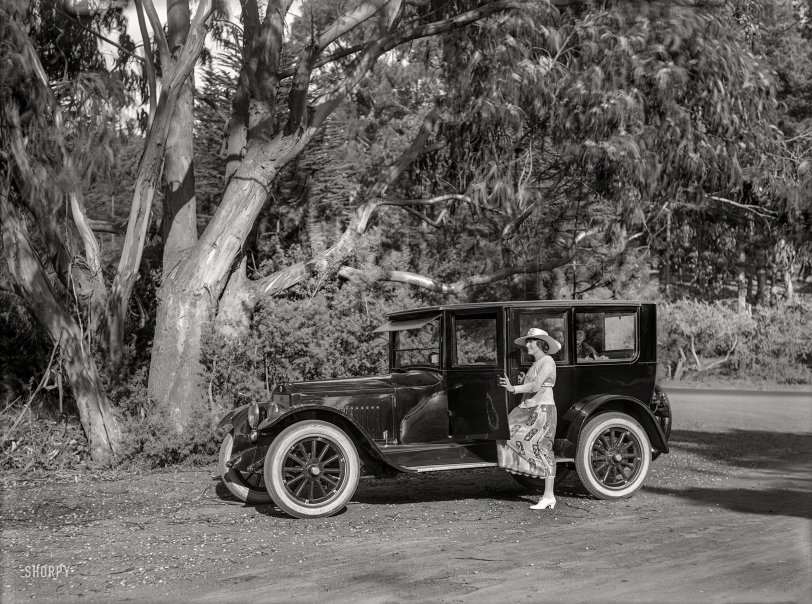


Framed or unframed, desk size to sofa size, printed by us in Arizona and Alabama since 2007. Explore now.
Shorpy is funded by you. Patreon contributors get an ad-free experience.
Learn more.

- Baldwin 62303
- Baldwin VO-1000
- Cold
- No expense spared
- Tough Guys
- Lost in Toyland
- And without gloves
- If I were a blindfolded time traveler
- Smoke Consumer Also Cooks
- Oh that stove!
- Possibly still there?
- What?!?
- $100 Reward
- Freeze Frame
- Texas Flyer wanted
- Just a Year Too Soon
- WWII -- Replacing men with women at the railroad crossing.
- Yes, Icing
- You kids drive me nuts!
- NOT An Easy Job
- I wonder
- Just add window boxes
- Icing Platform?
- Indiana Harbor Belt abides
- Freezing haze
- Corrections (for those who care)
- C&NW at Nelson
- Fallen Flags
- A dangerous job made worse
- Water Stop
Print Emporium
Standard Equipment: 1920

There is something about the snug click of the door latch and the clean, windless interior of a closed car that makes you feel at home and comfortable in there. The deep-cushioned seats, the curtains, the glass, the conversation in low tones -- all these things make getting somewhere as pleasant as being there. Getting home is never a problem, and the weather is but an incident. In the Standard Eight Coupe, Sedan or Sedanette, the powerful motor carries the extra burden of a closed body with an effortless ease ...
-- "People Don't Regret Buying Closed Cars" (Ad from 1921)
San Francisco circa 1920. "Standard Eight sedan at Golden Gate Park." The Standard ("Monarch of the Mountains"), manufactured in Butler, Pennsylvania, from 1912 to 1923, was a product of the Standard Steel Car Company, maker of railroad rolling stock. 5x7 glass negative by Christopher Helin. View full size.
Closed cars
They were always available, as soon as cars of sufficient size began to replace motorized buggies.
Riding in a dry place with no wind was always a strong attraction, but closed cars faced a whole list of barriers that did not really break down until the later 1920s.
Almost all early bodies were framed in wood with elaborate joints and much bracing to keep doors functional and joints tight through the racking of driving on mostly bad roads.
This the bodies (especially four doors) substantially more expensive than roadsters and touring cars. Also, this type of construction deteriorated rapidly except perhaps in cars used only on city streets, and they soon succumbed to sagging doors, leaks, and general debilitation while their open bodied brothers were still functional.
Safety was also a major concern. Safety glass was still in the future, and the worst and commonest closed car crash injuries were caused by big, razor sharp chunks of plate glass flying around, often causing catastrophic bleeding.
Changeover to stamped steel construction moved rapidly in the later 1920's and rapidly reduced costs and improved rigidity and durability. Small scale uses of various types of safety glass came along, and at the end of the decade Ford moved to safety glass (driven by glass injuries to a Ford manager, I think) windshields and then as rapidly as production volume caught up to full use of safety glass. Just from observation I would say that our auto fleet moved to a very strong domination by closed cars in maybe 5 years, say 1925-1930.
By the way, all those failing wood framed sedans I mentioned had their bodies cut away and became the home-made open trucks preferred by all the folks in Shorpy pictures of migrating Okies.
[Mass-produced all-steel bodies made their debut in the mid-1930s, starting with General Motors' "Turret Top" cars of 1935. Up until then, roofs on closed cars were generally made of rubberized fabric stretched over a wooden frame. - Dave]
"Conversation in low tones"
Really a lost art.
Like Sliced Bread
It's amazing to think that enclosed automobiles came later, even though enclosed carriages had been around for centuries. I have to assume it was a cost issue. Or maybe weight?
A Very Nice Example
of "Perpendicular Period" styling.
[Early Perpendicular. - Dave]
The old lady in back
She can remember covered wagons! I often wonder what the 20th century seemed like for people born in the 1830's and 1840's who lived long enough to see all the modern advancements. My mother's grandmother died at 96 in 1927, still living by herself in a gaslit house where she cooked every meal from scratch on a wood stove.
























On Shorpy:
Today’s Top 5